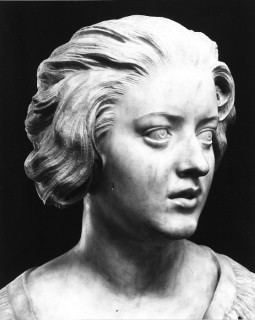Year 1636–37 (1636–37) Medium Marble Period Baroque Catalogue 35 | Type Sculpture Dimensions 72 cm (28 in) Created 1635 Genre Kinetic art | |
 | ||
Gian Lorenzo Bernini artwork Two Busts of Cardinal Scipione, Bust of Cardinal Richelieu, Bust of Gabriele Fonseca, Saint Bibiana, Bust of Pope Gregory XV | ||
The Bust of Costanza Bonarelli is a marble portrait sculpture by the Italian artist Gian Lorenzo Bernini, created in the 1630s. It is housed in the Museo Nazionale del Bargello in Florence, Italy. Considered among the most personal of Bernini's work, the bust depicts Costanza Piccolomini Bonarelli, the wife of Matteo Bonarelli, one of Bernini's pupils and coworkers. Bernini fell passionately in love with her. It is an exceptional sculpture in that it breaks with the tradition of seventeenth century portrait sculpturing and previews the style of the next century.
Contents
Subject
The subject of the work is Costanza Bonarelli, with whom he fell in love when her husband was working as Bernini's assistant in 1636. The normally polite Bernini openly insulted the husband, which led Pope Urban VIII to intervene before anyone was killed. He advised Bernini to get married, which he did, in 1639, to Caterina Tezio. Their marriage lasted 34 years and produced 11 children. Bernini would remain professional and increasingly religious to the last, when another Pope blessed him on his deathbed.
Theme
Bernini's theme in Bust of Costanza Bonarelli is the vitality of power. Bernini's aesthetic is centred on the power of sex, later epitomized in the Ecstasy of Saint Teresa (1647–1652). For Bernini, Costanza is an angel that fills him with ecstasy.
Distinguishing features
The Bust of Costanza Bonarelli invites such anachronistic descriptions as impressionist, romantic, and rococo. It has been described as being "light as air". Jonathan Jones wrote:
He has made an intimate monument to secret moments, a sculpted memento of his lover, whose marble reality dissolves, when you chance on her among the stony dead, into breath, life. Bernini's genius for motion is dedicated to making his lover live for ever. Her wild hair and loose clothes speak of energy and passion. He has caught her mid-glance, mid-conversation, perhaps before or after sex.
